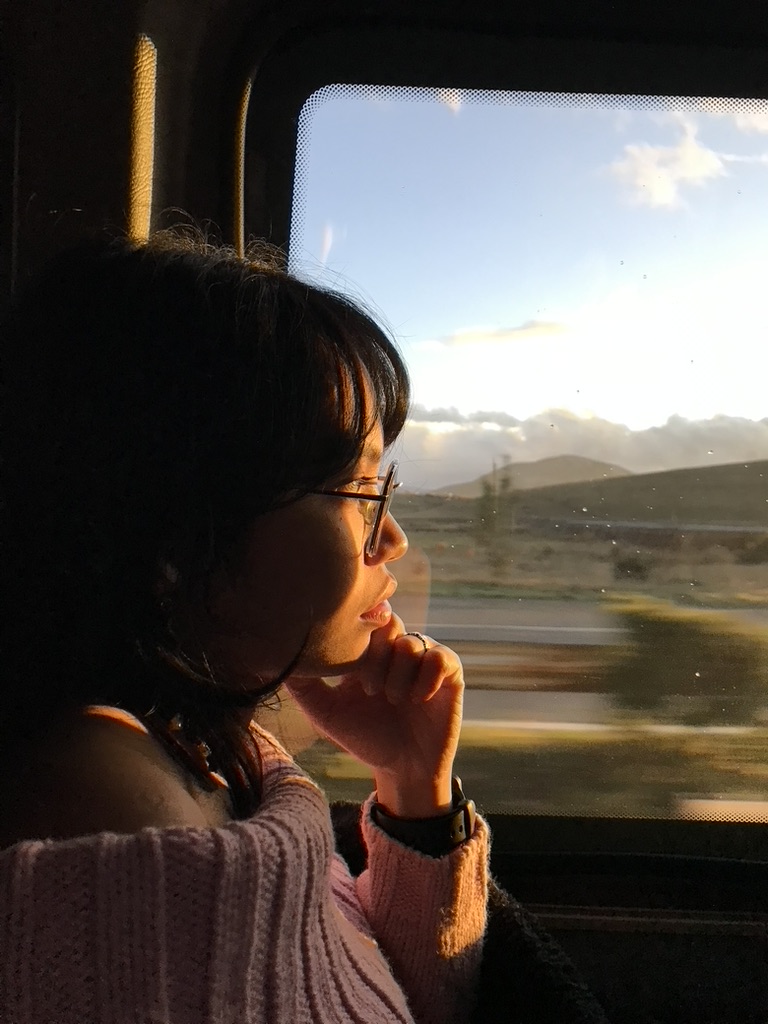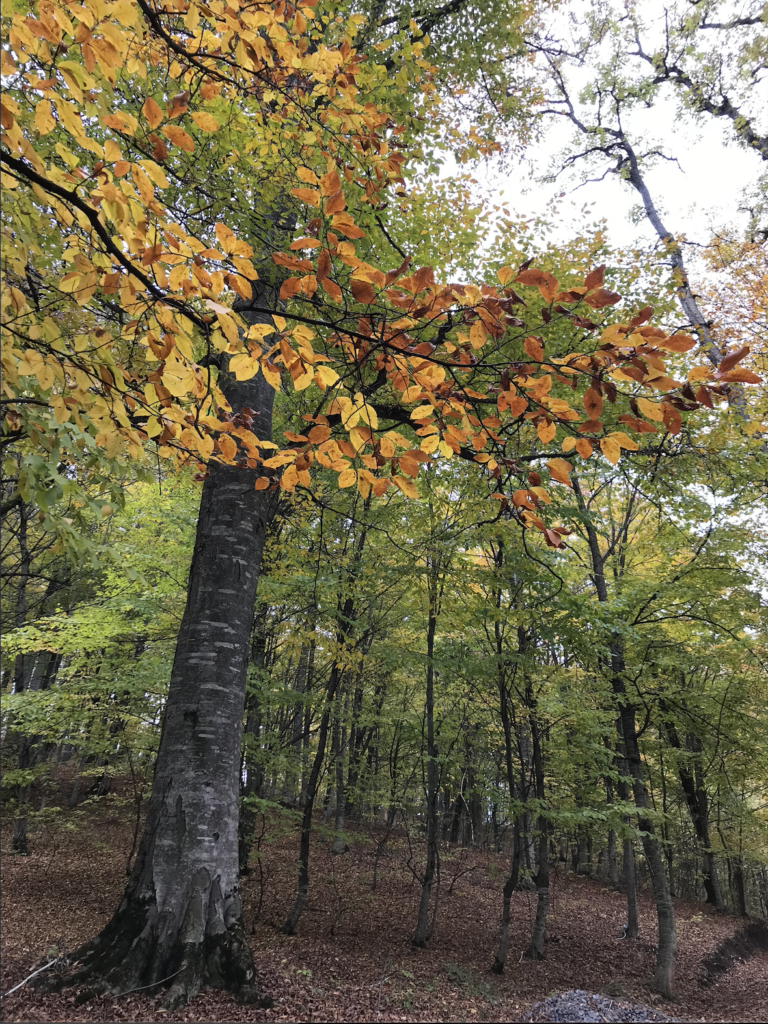(A backlog post! For the first of the year. Note: around the first half, or two-thirds of this was written on the same day as the trip I’ve written about – 26th of October, 2024 – while the second was written today :P)
I have been wanting to go into nature for a long time. I longed to get lost in a forest or stare at a high mountain from afar… Blame it on the poets I’ve read or musicians I’ve listened to – those who went into the refuge of secluded mountainsides or plains to find themselves. Being stuck in the middle of the city, I had wanted this especially throughout my gap year (I’ve started my graduate classes now.)
I figured that my new task of tending seedlings and plants in our balcony was also about me learning to commune with God in nature as He taught me plenty of spiritual lessons through the metaphors Christ used in His parables that I experienced myself. I also did my Bible devotions in parks but I would be disturbed by cigarette smoke from 360 degrees around me. Finally, I got to go out again when my family and Filipino and Armenian friends went out to Dilijan (and a brief time in Sevan) to bring a visiting friend from the Philippines. He’d wanted to see autumn’s colours in Armenia so we happily toured him around.
Autumn in Dilijan, a province of Armenia, has been something I always desired to see ever since I moved here. I saw pictures of the trees dressed in red, yellow, green, and brown – looking quite fluffy on the hillsides and being reflected in infinite blurriness in the lakeside; a wonder I wanted to behold. As someone who grew up in the Philippines, we never have winter and fall and spring, only either wet or dry; and in Kathmandu, Nepal, we didn’t have this kind of colourful display. (Also, side note: I like using “autumn” over “fall” because of my synesthesia – “autumn” matches the leaves’ colours more than the plain yellow-pale pink of the word “fall,” which is a word that also signifies other concepts than this beautiful season.)
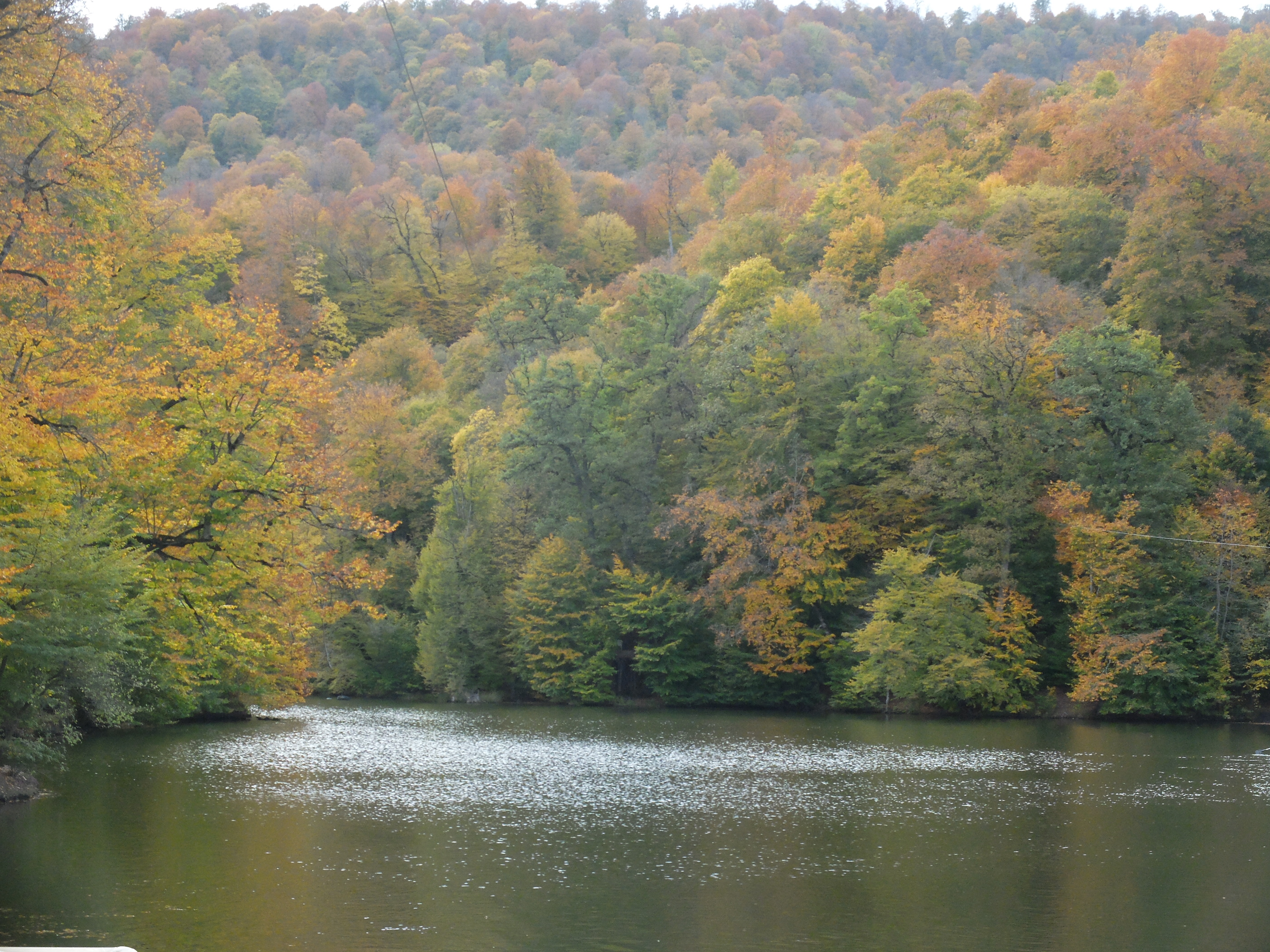
My first time seeing Dilijan in autumn was only last year (my sixth year here), because in our first years here we’d be in the Philippines during the autumn season, and lately, I was at university (and during COVID for almost half of it) so I didn’t get a chance to go there. Last year was magical, because I had known the places we’d visited there when they had worn their summer identities, so I encountered them again in their autumnal majesty.
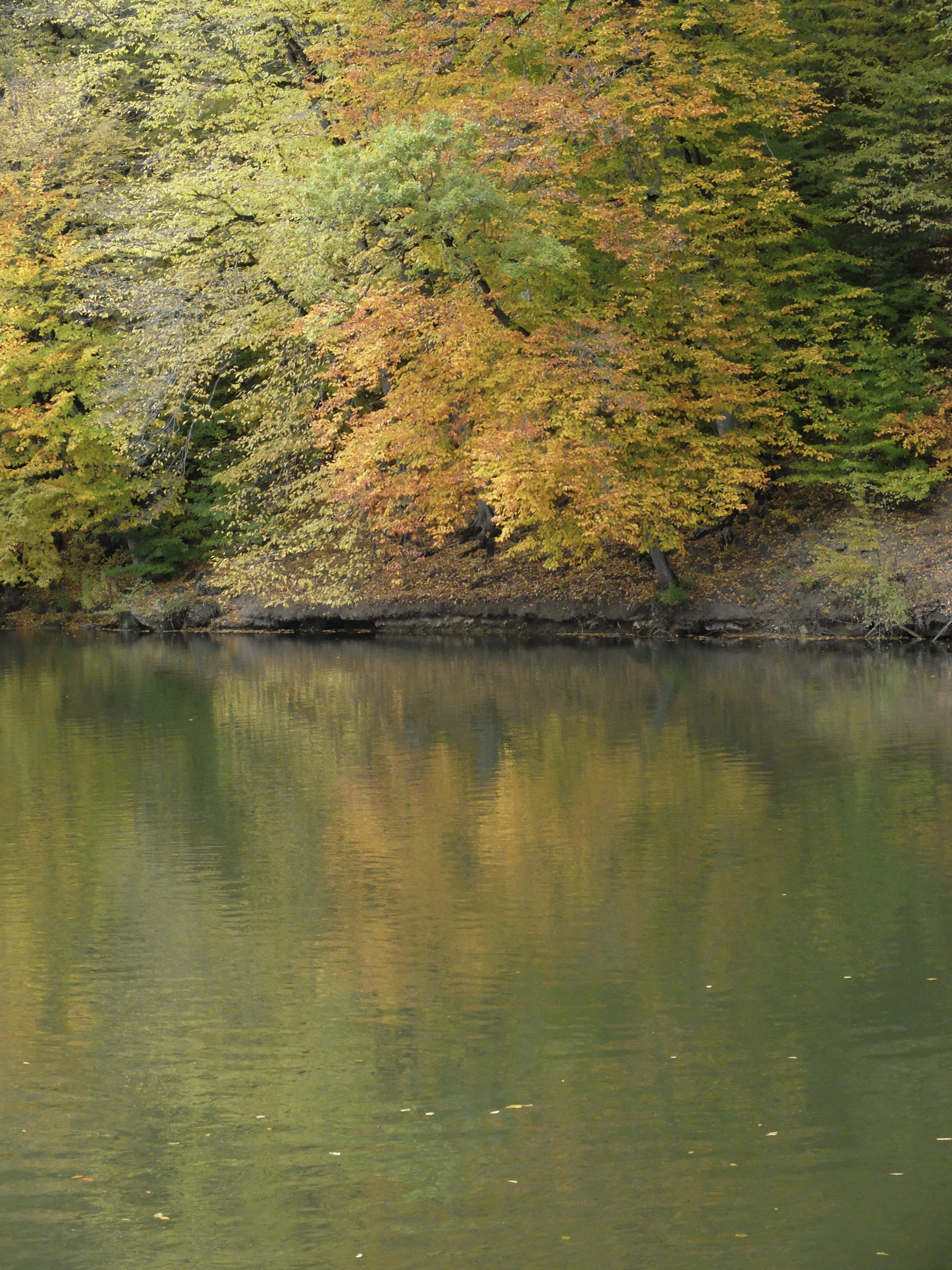
This time – well, it seems that the leaves changed colours later compared to last year, as my parents told us as they brought several tourists on excursions around Armenia throughout the past month (October). Even in Yerevan, although it’s been colder vs. last year, the trees aren’t fully changing their leaves yet.
So, anyways, today we set out in the late morning. We made a brief stop at Tsovagyugh, in the Lake Sevan region, then headed for the tunnel towards the tree-clothed hills of Dilijan.
Before that, I looked out of our Sprinter’s window to see the surrounding barren hills. In summer, these enormous, sloping green hills look like they came straight out of a Windows screensaver. I think it was my first time seeing them in autumn like this (lol I wasn’t paying attention last year probably) because – in winter they’re covered in snow, but today they evoked winter in their dryness and coarse, sometimes, velvety brown. Yet it wasn’t fully dry. It was like in the process of moulting – there were thick brown bushes peppered with pink-red berries. They were so beautiful all together, and I was reminded of C.S. Lewis’ Malacandra plants – otherworldly and alluring. I wish I took a photo of them for this post (I’ll try to search my family’s pictures) but at the moment I decided to just behold them and imagine Malacandra and let my mind wander.
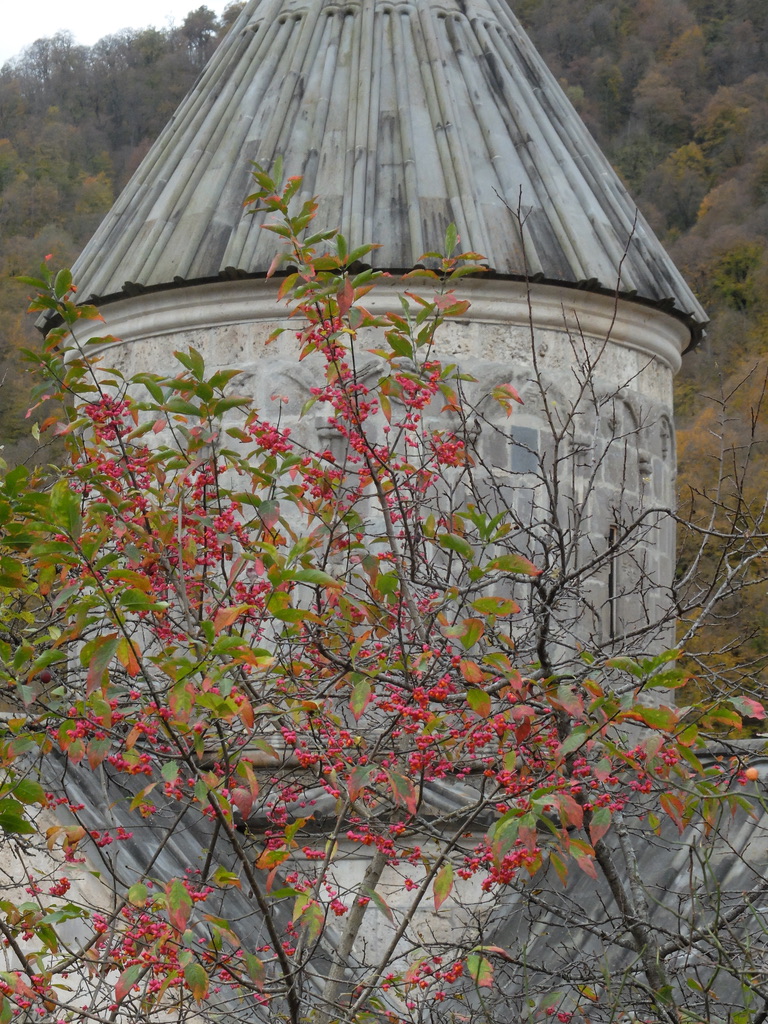
A word on the act of beholding. Earlier this year, my friend J-Ann, a kindred spirit in words and a love for the arts and God’s kingdom, shared with me her favourite Christian magazine, Ekstasis, and one life lesson / philosophy she shared from there that has stuck with me ever since was the idea of how important it is to be still. To be still before God, to be still before nature, to be still and just behold, accept – to be instead of always being in a state of doing. To love being instead of worshipping the act of doing.
In our media-saturated world, we love to post everything we do; taking pictures of everything to post and share to our friends, that we forget to be in the moment and focus on enjoying whatever it is we’re doing in the present. Yes, it’s good to stay connected online especially to our family and friends who live on different spots on the world, but I think it’s just too much nowadays with social media. I’m guilty of wanting to share IG stories to show off or to get views. So I think J-Ann’s reminder to just be was a good warning for myself.
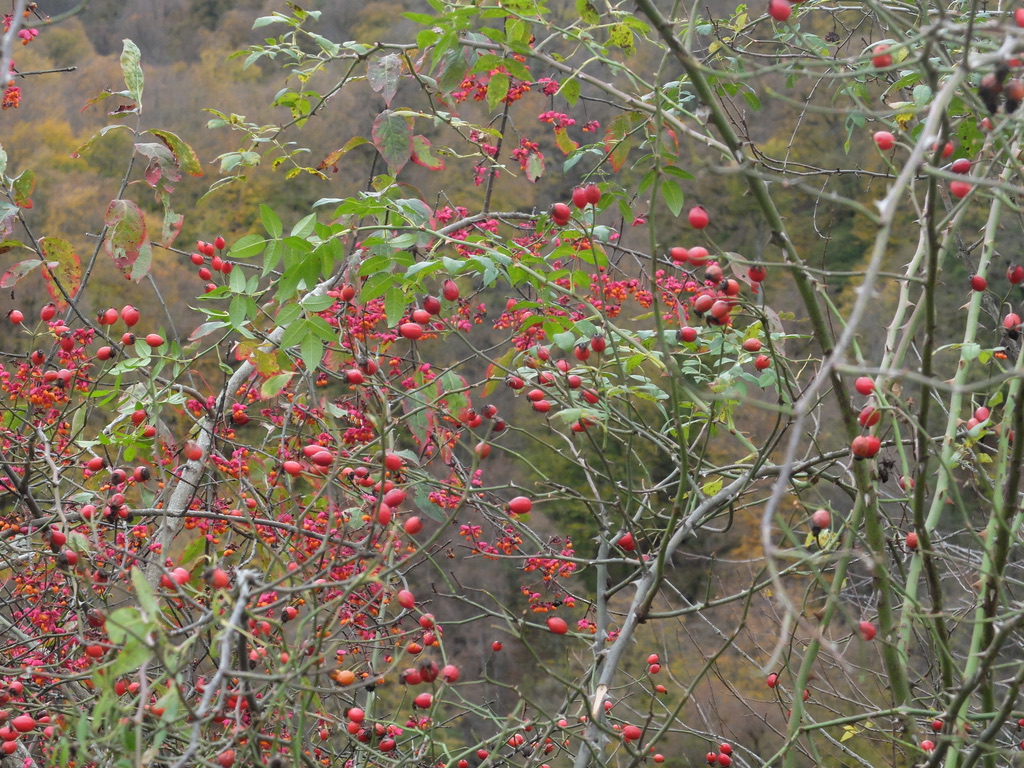
Anyways, back to my story, though I’ll refer to the idea of beholding later on. We went through the tunnel (one that was built in Soviet times, as Araksi, our Armenian friend, shared as a fun fact lol) and emerged out of it facing the subtle hues of dark red and dark yellow with the thick green on the hills.
I love that the road down to Dilijan is a zigzag one that gives each car window’s side a view of the trees parading different colours. Then I saw a scene of the hills from different levels – one had a grassy slope with a small scattering of houses on it, and with the tall, snow-capped and grey mountains in the background, which took my breath away. My immediate response was to try and take a picture of it, but my photographer’s mind realised that the scene was too far away for either my phone or Fujifilm X-20 to capture it accurately, while also taking account that the car was moving too fast for a clear shot.

I’ve also tried not to be a perfectionist about the act of beholding itself, but I judged that I did behold the scene enough for it to warrant me to do the secondary act of taking a picture, and of course, posting it.
We headed towards Haghartsin Monastery at around midday, and along the way, we passed by a yellow and orange forest, with our vehicle sometimes driving beside slopes of autumn leaves leading down to a distant brook that looked so coldly refreshing. It brought to mind Narnia and Middle-Earth (especially Lindon’s trees), and I was just delighted.
There would be small benches with tables, and I wondered what it would be like to hang out down there. Chillingly cold, yes, but, wow, wouldn’t it be marvellous to sit surrounded by flaming leaves and the breeze rippling through the branches above and the carpet of brown, crunchy leaves below?
We finally reached Haghartsin after about twenty minutes from the Dilijan city center, and we went to the churches.


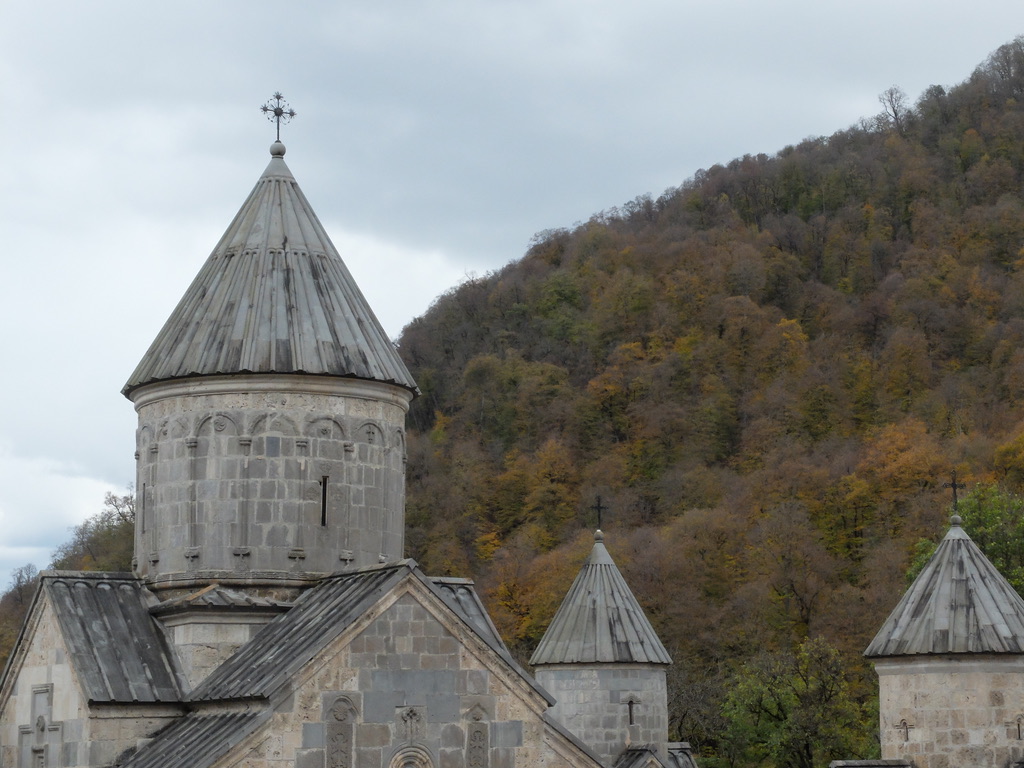
I broke away from our group a little later to meditate in the St. Stephanos (St. Stephen) church – recalling the searing, beautiful sight of the yellow leaves on the trees, while recalling how Stephen died as a martyr for God, which made me think of how God desires to restore the true beauty of creation to Himself through Christ, and that would take pain. He has carried pain in His heart, and as His children, we also grow to receive His compassion and suffering and contain them in our heart like a martyr’s.
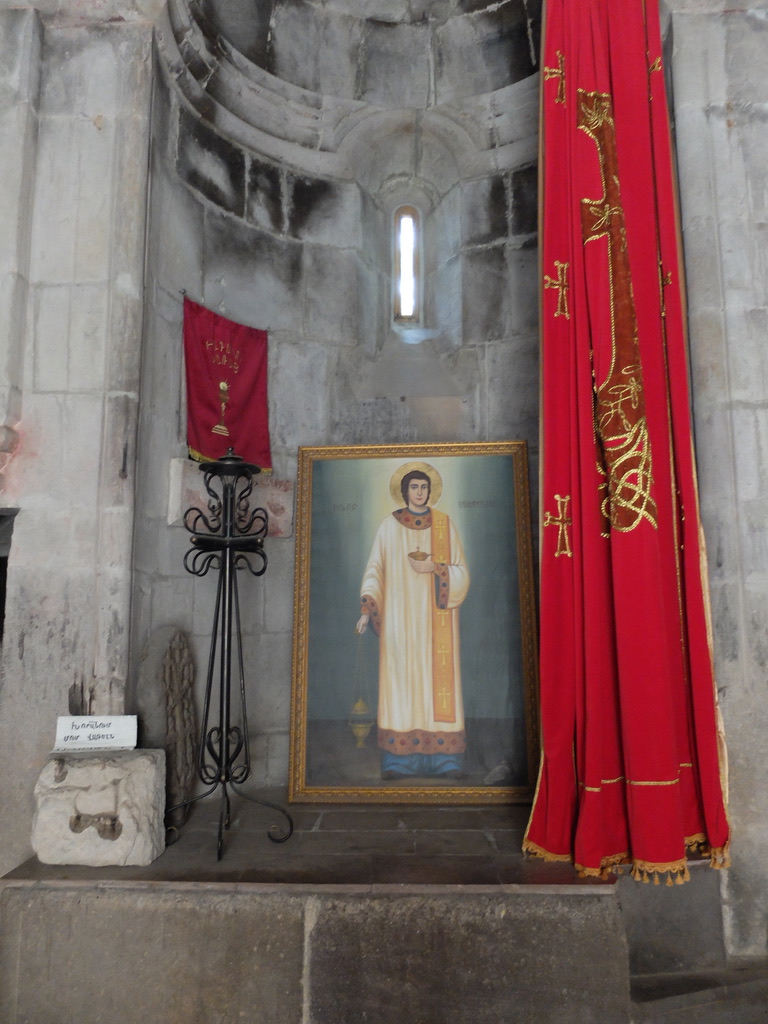
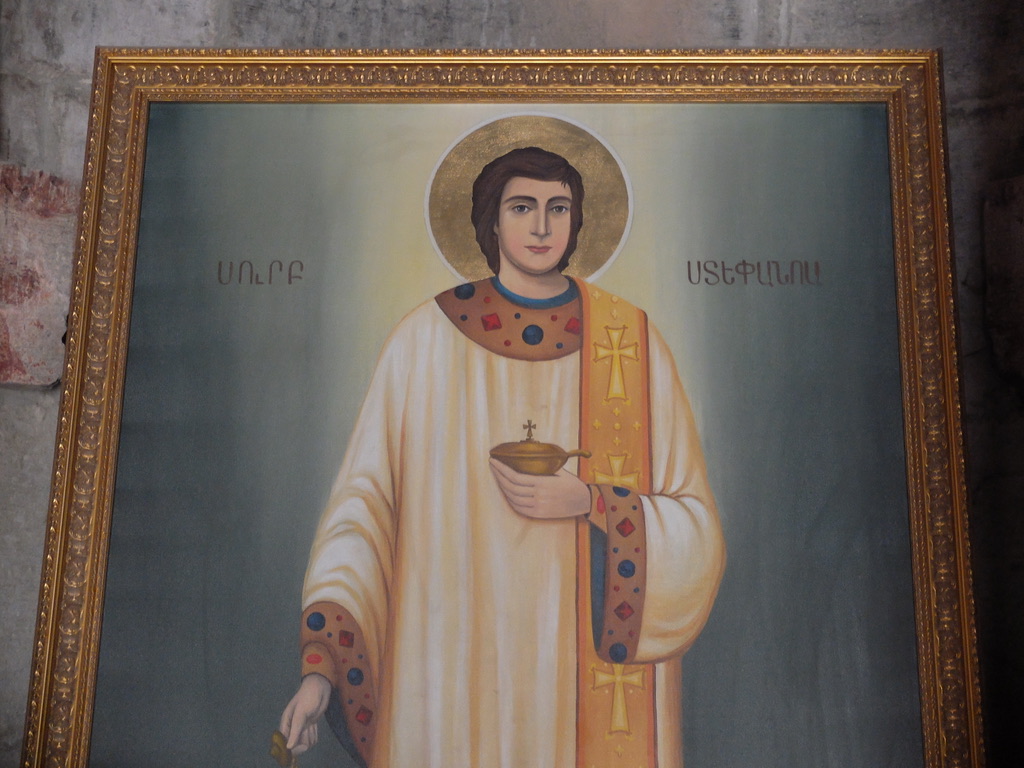
After the churches, we bought and ate some gata (a traditional Armenian sweetbread) from the bakery next to the complex – Haghartsin is a favourite place of ours to get it fresh.
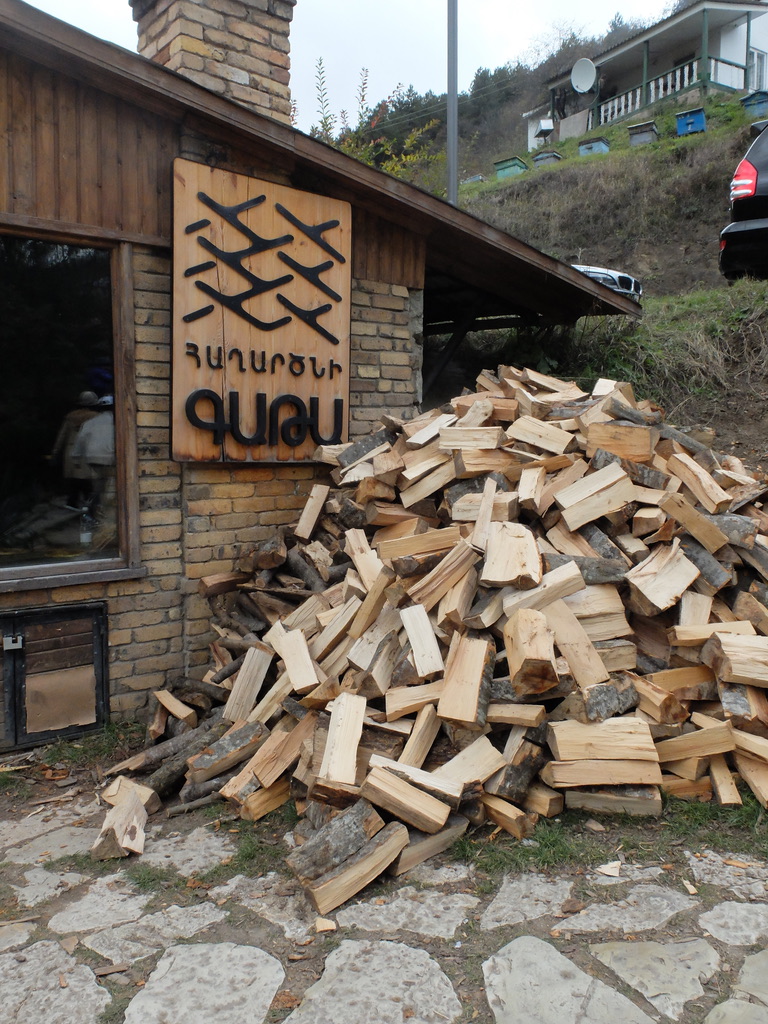

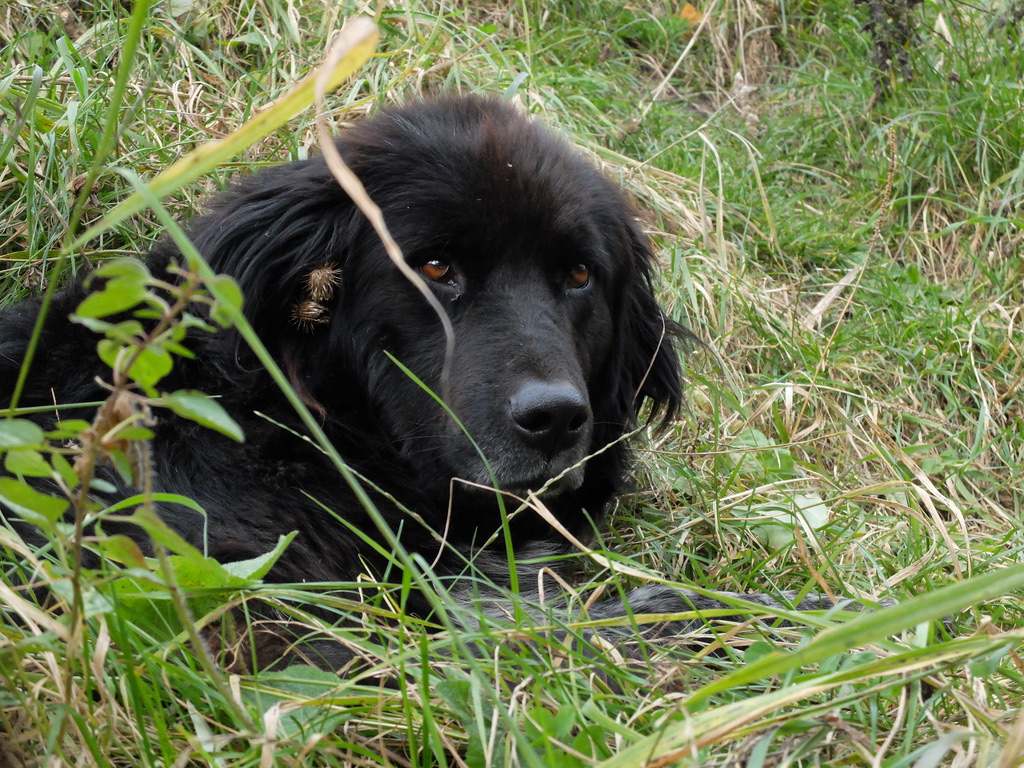
We made some new friends from Vanadzor, speaking to them in Armenian – and they even sang for us! pretty neat – then we climbed back to our van and headed for Parz Lake.
Driving uphill, we stopped in front of the Red Deer Sanctuary to take pictures on the tree-framed mountain road. I recalled listening to Howard Nemerov’s “Trees” poem here in the summer of 2021 (I think it was that year), and it was fun taking portraits of my sister Abbie with Maryam throwing a bunch of dried leaves for effect (but they kept being blown by the wind to the opposite direction 😟).

It was also hilarious how each of us families would pose in the middle of the road, while trusty spotters would yell if a car was incoming, to which we would skedaddle out of the way like escaping rabbits.
Five minutes later, we reached Parz Lich (Lake). I looked back at the entrance and recalled how my first time there was on a hot summer day during COVID, and there were lots of cars and people just excited to run around the place wearing shorts and sunglasses.
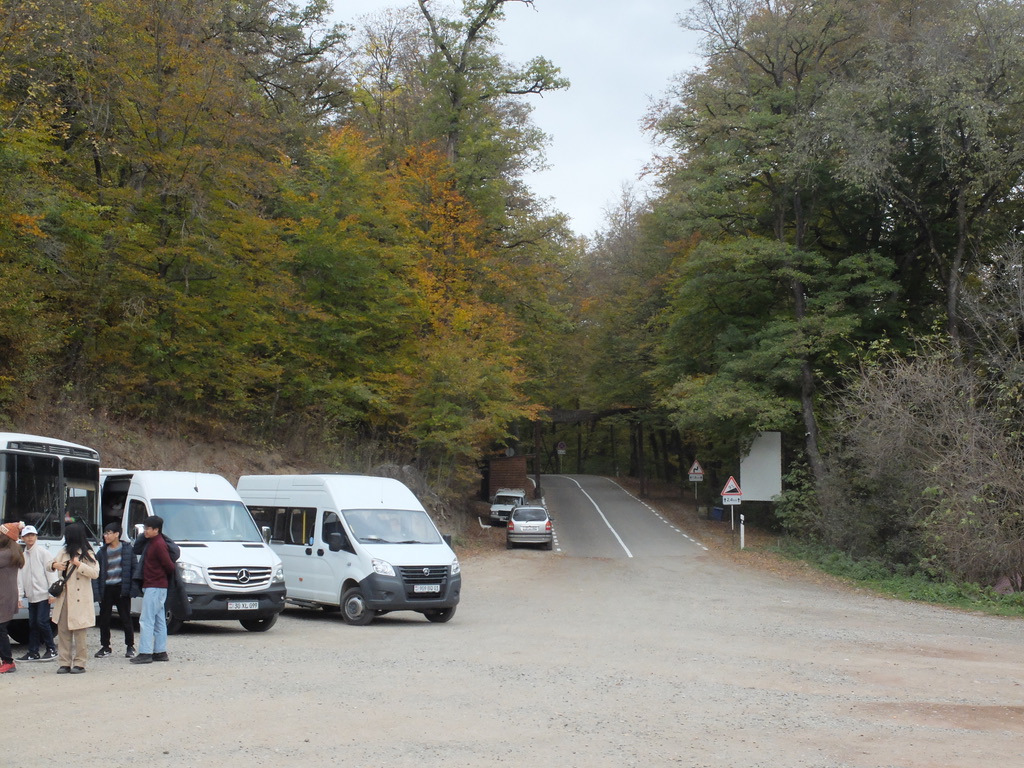
There were still a lot of people there today because it was a Saturday, and the ducks and geese on the mouth of the lake were still there along with people riding the zipline and pleasure boats, but it was bitingly cold. This gave way to a glassy scene of the lake’s surface tinted in dark green shades and wreathed in trees punctuated by fire-orange leaves, with the foggy mountaintops in the distance. The mountains – along with other panoramic views we saw later on – reminded me of the high mountains in Romania I had seen last year (but didn’t take a picture of)…
I walked ahead of my group and found benches on the lakeside to read my W.B. Yeats poetry (I’ve been bringing this book with me on these vacations for years now, and I still haven’t finished reading all of it) with my sore throat-inflected voice. Feeling insecure but also somewhat proud to be reading poetry among Armenian and foreign passersby, I recited my favorite poems like “He who wishes for the cloths of heaven” and “The Lake of Innisfree”. At one point, I decided to record one of them in a video while I was on a bench swing.
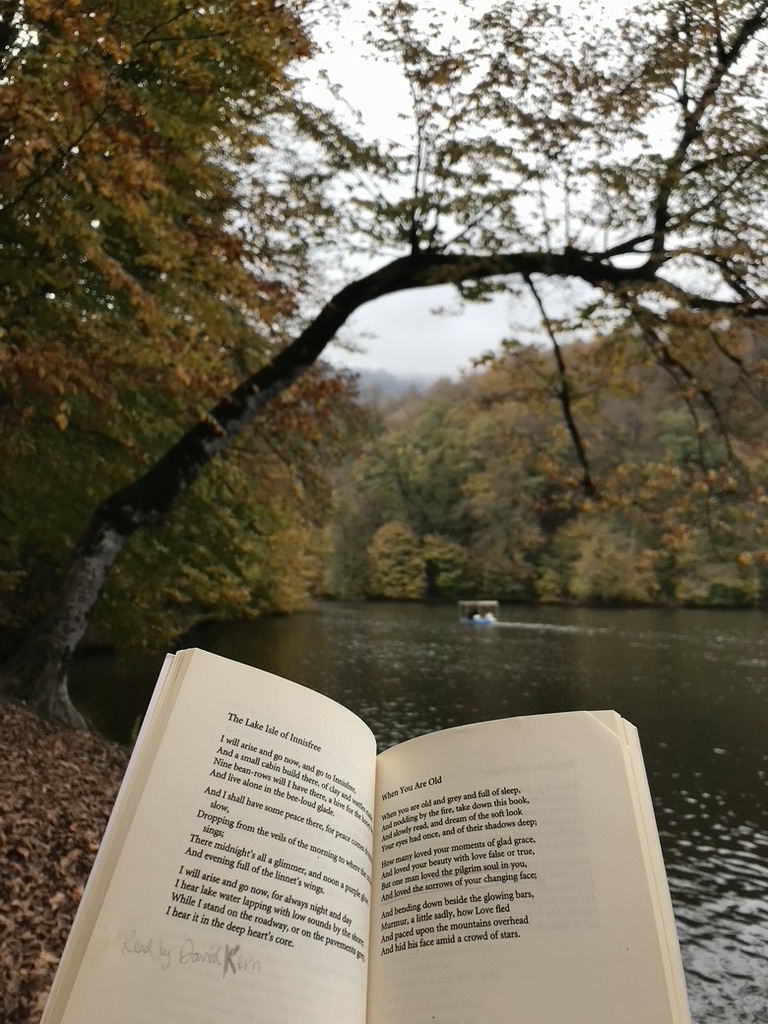
My morale was to promote both poetry-reading and Armenia (particularly Dilijan) to my followers on Instagram (haha lol it sounds funny to say “my followers on Instagram”), but I kinda felt like that was cheating the privacy of the moment of reading that poetry to myself. But I once read – and struggled with – Filipino poetry on that swing with Tita Merlee, who I consulted with difficult words and pronunciations. And I felt like the scene was pretty poetic too, so I didn’t mind so much to be recording it.
I walked to the lakeside and observed the water and the trees ahead, and again felt a desire to take a picture of it to post on Instagram, because it just seemed so Instagram-worthy. I stopped myself by asking if I beheld that beauteous scene enough.
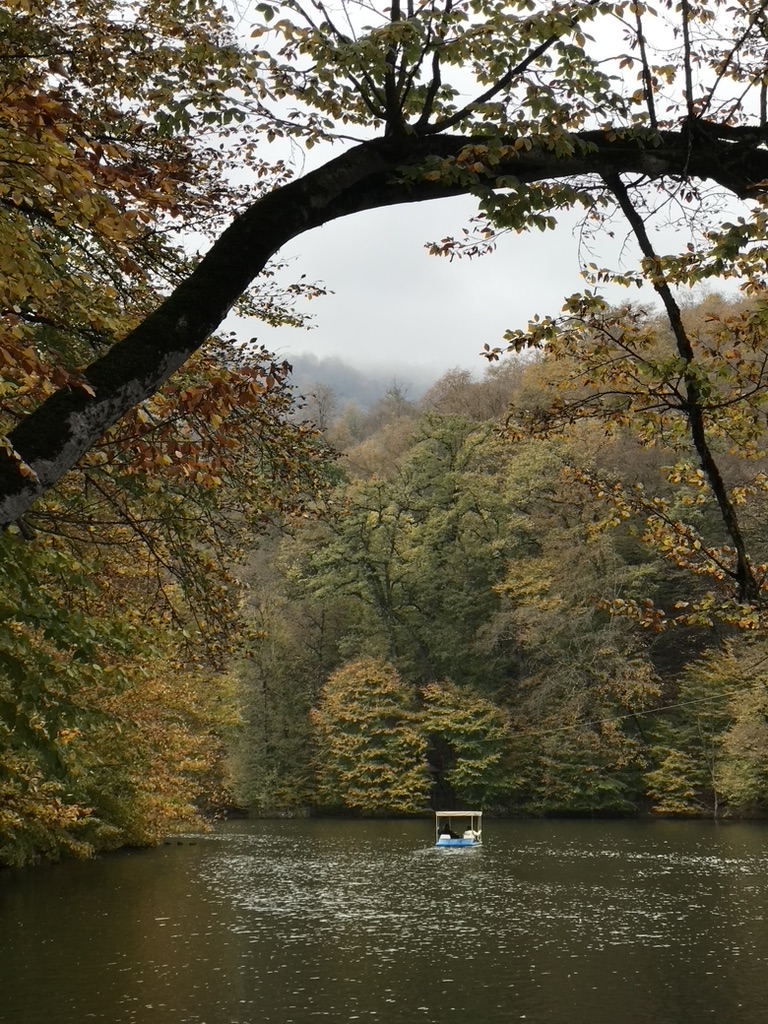
Then I felt a bit guilty going away from my group because one of our purposes was to spend time with our visitor… But when I considered going back to them, I saw from a distance that some of them had already gone on a boat with our Filipino friend. Some others had to stay behind because the boat didn’t have enough space, so I didn’t feel as left out. I waved to them as they passed by, and a minute later, the long wake of their boat reached my shore, and I heard the waves lapping loudly on my side. Aha, witnessing that unique wonder was the reason why I felt I had to stay, I thought.
Soon, I convinced one of my friends, Joshua, to walk with me into the forest towards the end of the lake, though I knew we would only get to walk a short while because it started drizzling, which would prompt us all to leave. We walked through the trail with grooves made by some vehicle and also trodden on by horses, and made little conversation. I thought of friendships I had read about and how some of them walked through nature without speaking much to each other but knew each other well enough to be content with that (my extrovert, city mouse brain was shocked finding out for myself that it was possible). I climbed up on a tree stump I once took a picture of my bird book on in the snow, and hopped down. We walked to a more open space and noticed a security camera up on a pole. Then, I got a phone call from Joshua’s dad telling us to come back because we were about to leave. My friend remarked how he was reminded of Narnia by the forest, and I mentioned Lord of the Rings at some point. After a discussion about birds, Sarah (Josh’s sister) said she wished she joined us but she didn’t bring a hat 🙁 I wish she also came because I knew we all needed more exposure to nature :p
Then we sat down on a bench for family pictures, which turned out great!
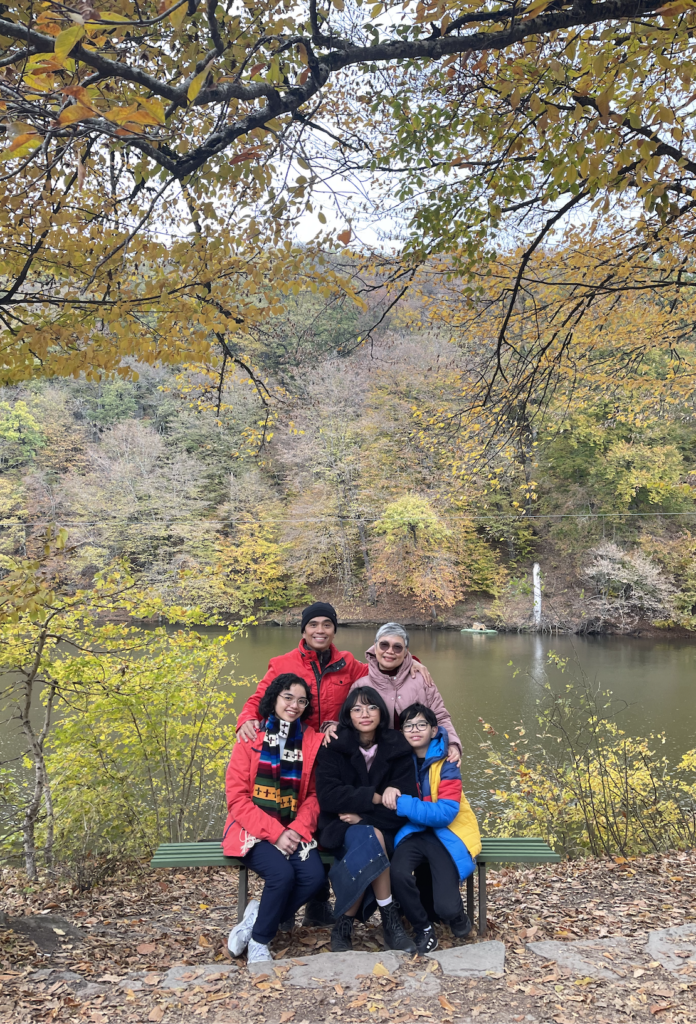
I also started drawing a tree with a fountain pen a family friend gave me:
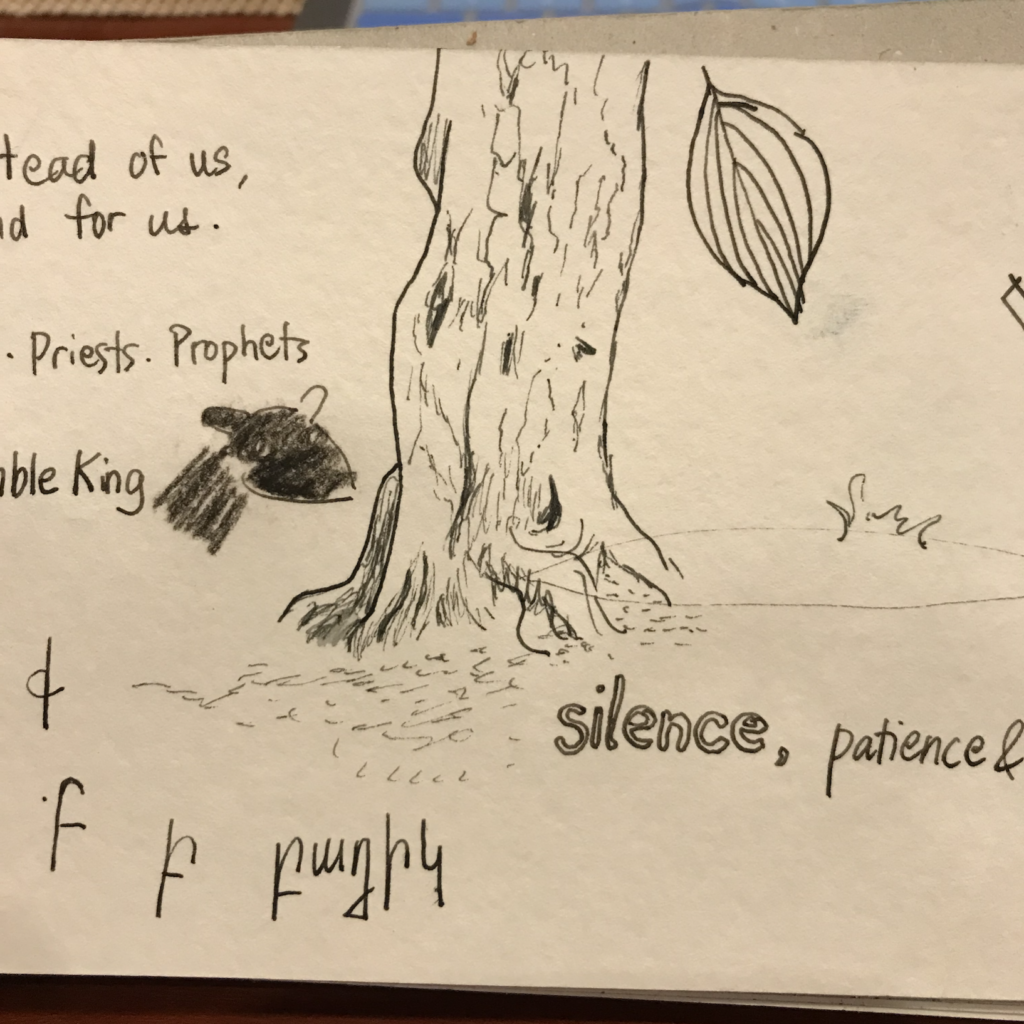
Maryam and I walked by the duck spot and she taught me how to say “duck” in Armenian (“badik” 🦆). I made another lame Top Gun joke by yelling, “Talk to me, Goose!” to a couple of geese there, and Maryam said about us, “People are thinking, ‘What are they doing?!’” 😂 Another reminder of the self-consciousness of my Gen Z generation (sorry for the redundancy lol).
— (Here I come back to writing two or three months later, let me try and jog my memory the best that I can.) —
We rode our Sprinter once more, and Maryam shared her material for making a cheese sandwich with me – some bread and the readymade square cheese that comes covered with plastic, a wonder for a Filipino like me who didn’t have it growing up – and we were laughing about it and other things while our window previewed a blurry scene of yellow forest, millions of yellow leaves running through us. It was so beautiful.
We stopped by Dilijan’s Old Town and spent only about 10 minutes there before going forward. It was my first time there and I had seen only pictures of the old, wooden verandas so iconic and similar to the ones in the Frunzik film

I think all of my family had gone there before with my aunt and uncle from the U.S., but I was in university so I couldn’t come with them. Funnily enough, I was walking down the sloping path when I saw someone familiar walking with his mom (I think) – he was wearing shades so I wasn’t sure who it was, and he took them off and I waved; it was my classmate from photography class at college.

A little later, Maryam offered to take a photo of me by the houses:
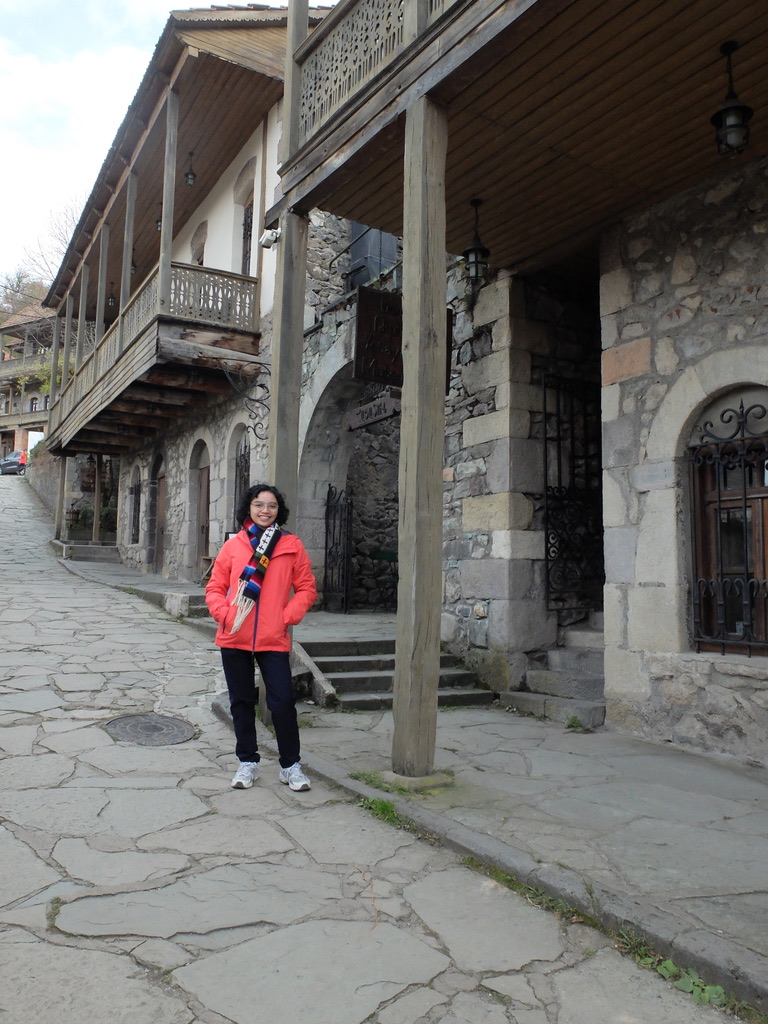
I also liked this view of the city with the juxtaposition of the khachkar and the white sculpture that commemorated the 50th anniversary of Soviet Armenia:
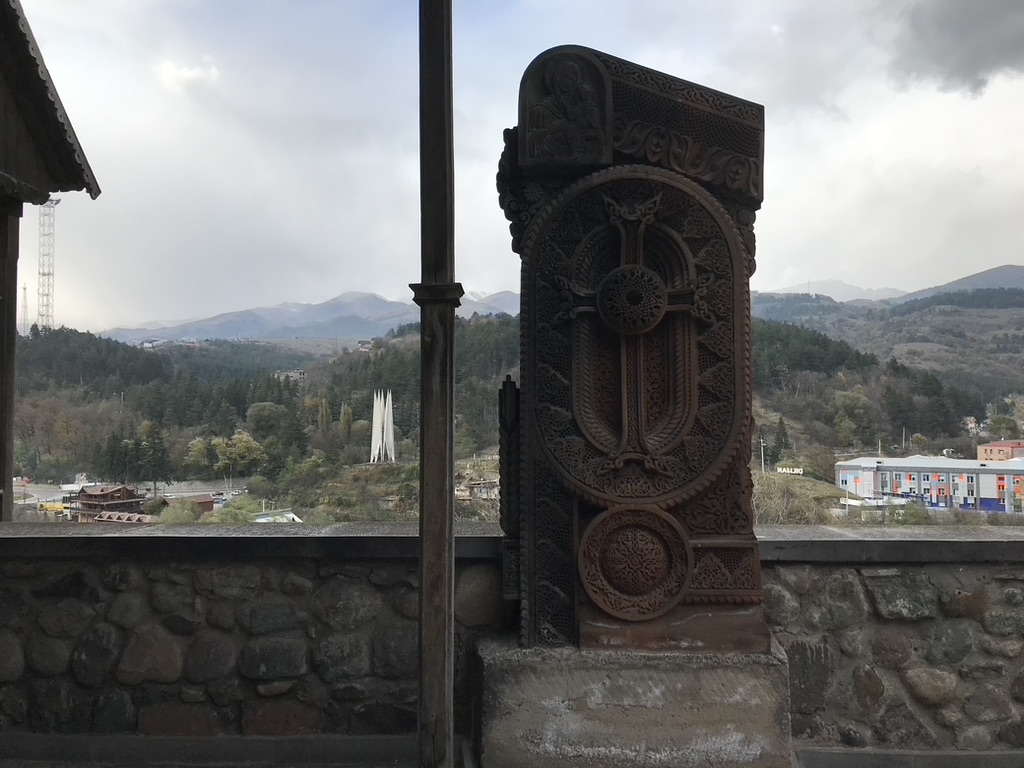

Next, we drove off to Tsovagyugh for a late lunch (including their fish from Sevan), and Maryam borrowed my sketchbook and fountain pen to draw the gloriously-warm fireplace (another wonder for a Manila kid like me). It was fun seeing a Filipino tour group there as well, hearing our language and understanding them.
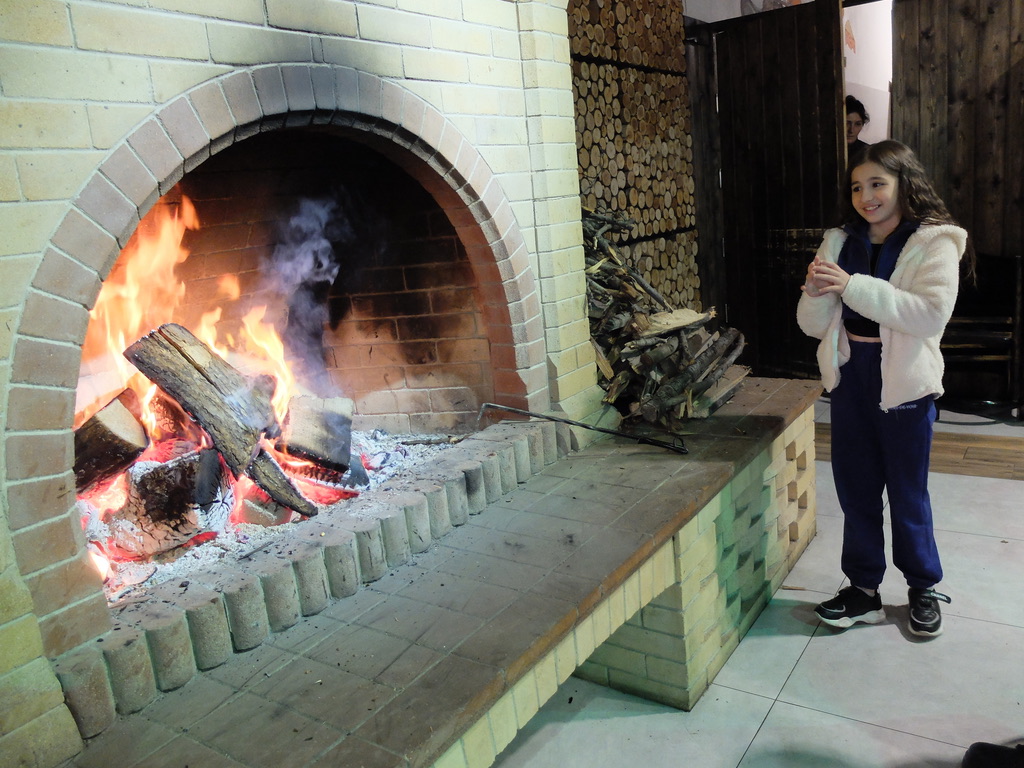
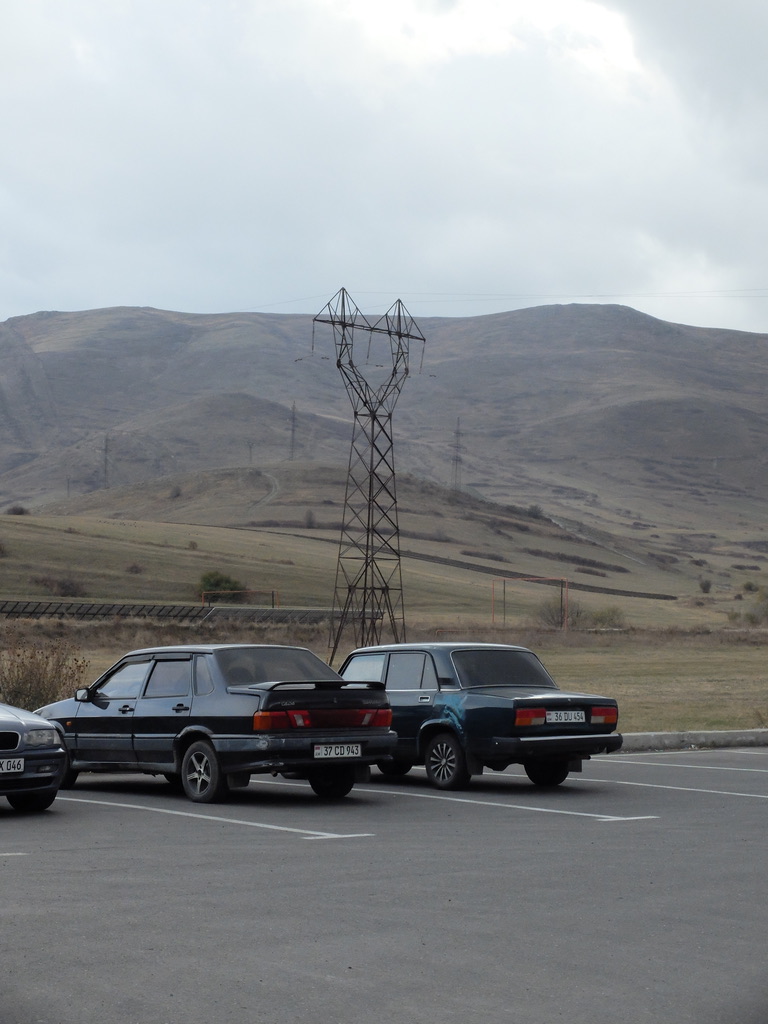
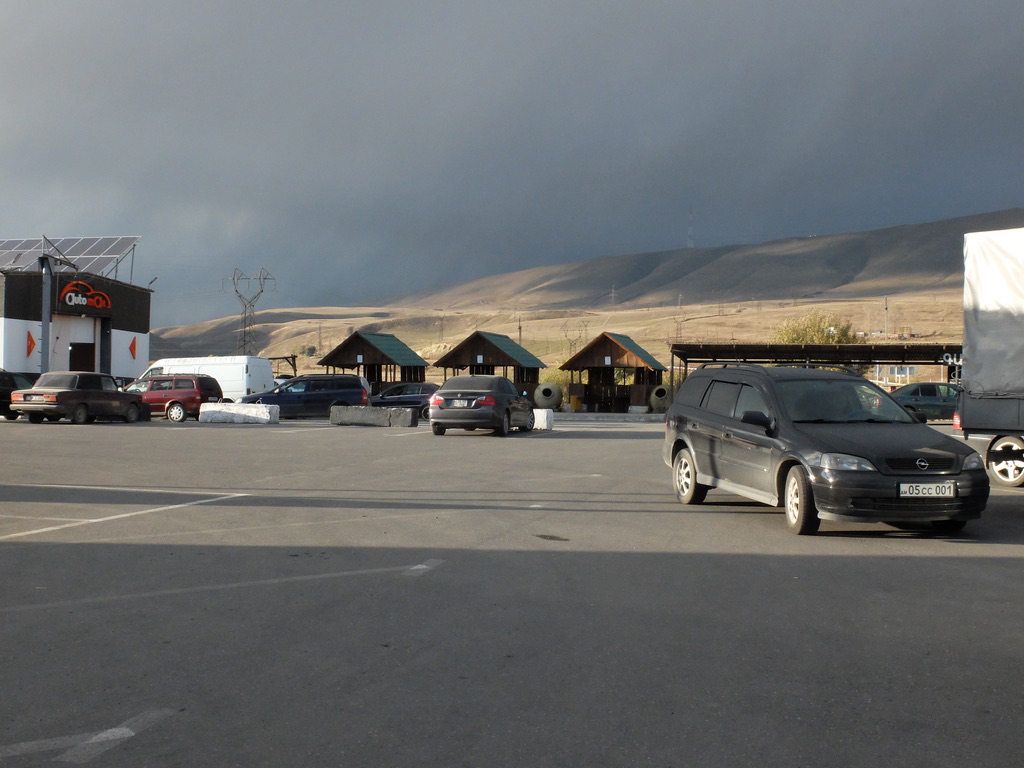
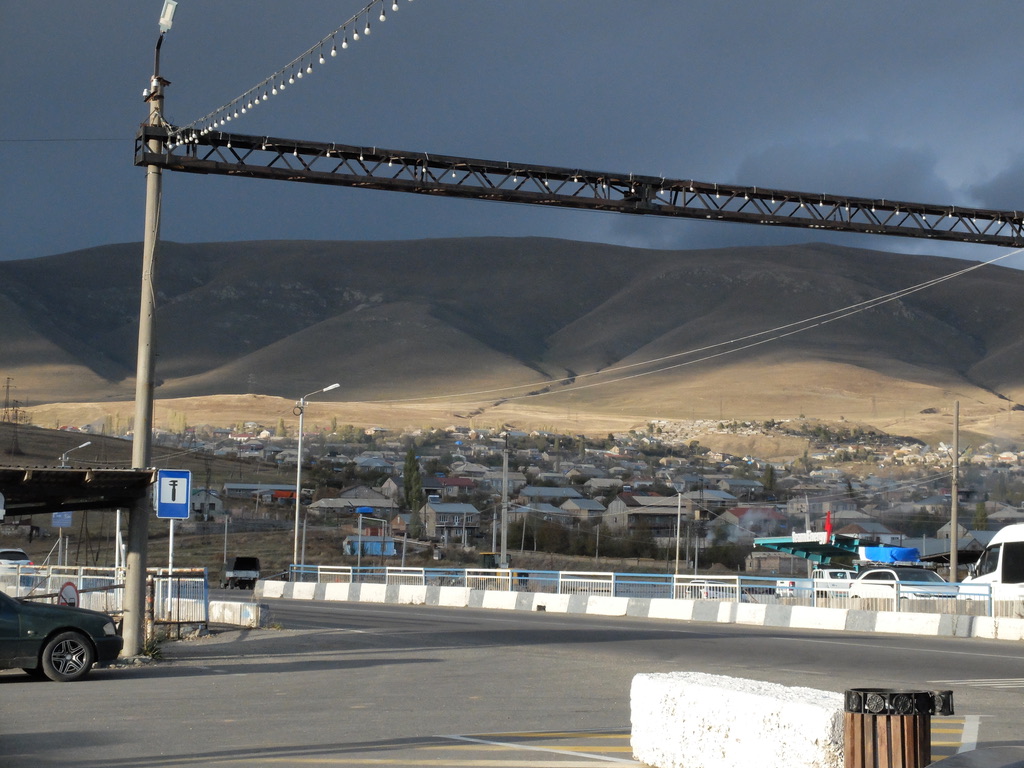
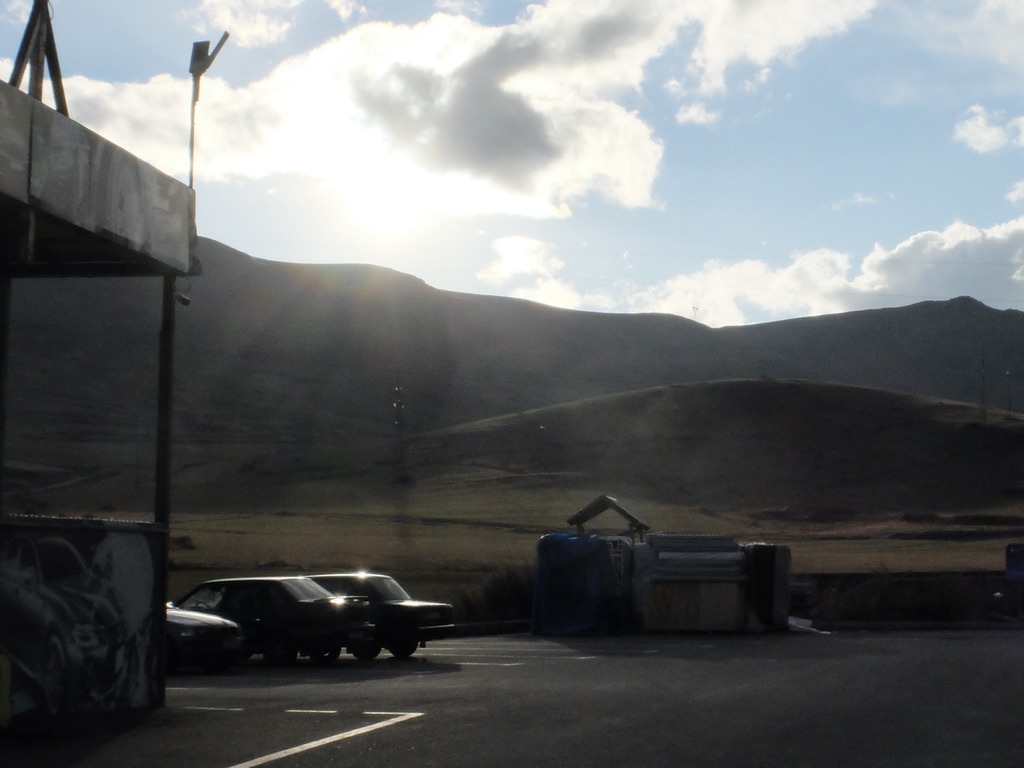

With full bellies, we drove to Sevan briefly so we could take our guest up to Sevanavank. Only Dad and I accompanied him, however. I got another collectible coin there; look at the marvellous sunlight at that time:
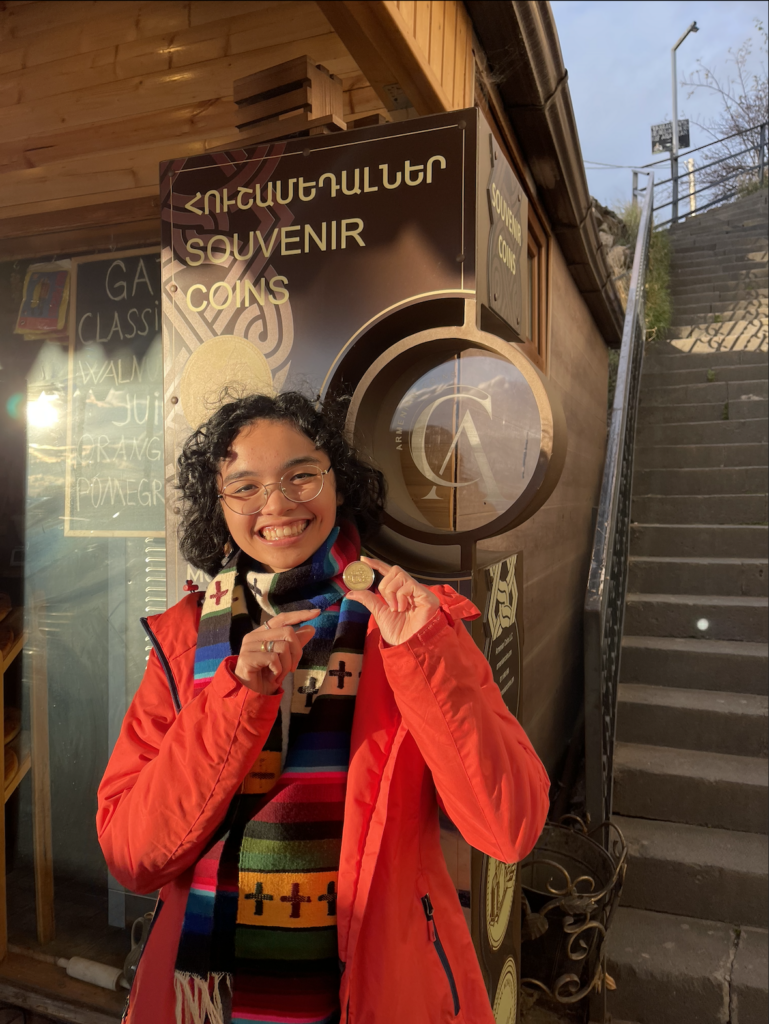
We climbed up, but I asked my dad and our guest to go on without me because it got terribly cold.
Instead of going straight down, though, I stood to marvel at the panorama of lake and sky and town around me. It was the kind of scene that was ineffable, impossible to describe; it had the kind of wonder to silence one before the sunburst, the sparkling waves – the pristine handiwork of God. But I’ll try to describe it anyway.
On my right, the side of the monks’ living quarters if I’m not wrong, the sky was overcast over that side of the lake, which was silent, with only the hills as its witness. The left side: the sun was shining over the lake in his final encore before leaving us for the day; a grand finale of light – cold wind around me, dazzling, yellow-tinged brightness above me… and I praised God silently before that wide vista of the lake, where some boats could still be seen like specks in the distance. I looked straight ahead – the middle of the two sides of the lake – near the mountains, where I saw the diffused yellow haze of clouds as I meditated – and suddenly, I heard my name being called far below me, where the town was. I tried to find who it was; I spotted our Sprinter but couldn’t see the caller. I sadly decided to start descending, when it suddenly began to drizzle. I thought, “Man, that was right on time….”
I rushed down to the street, passed by Joshua chatting with a young shopkeeper, as the rain was pouring.
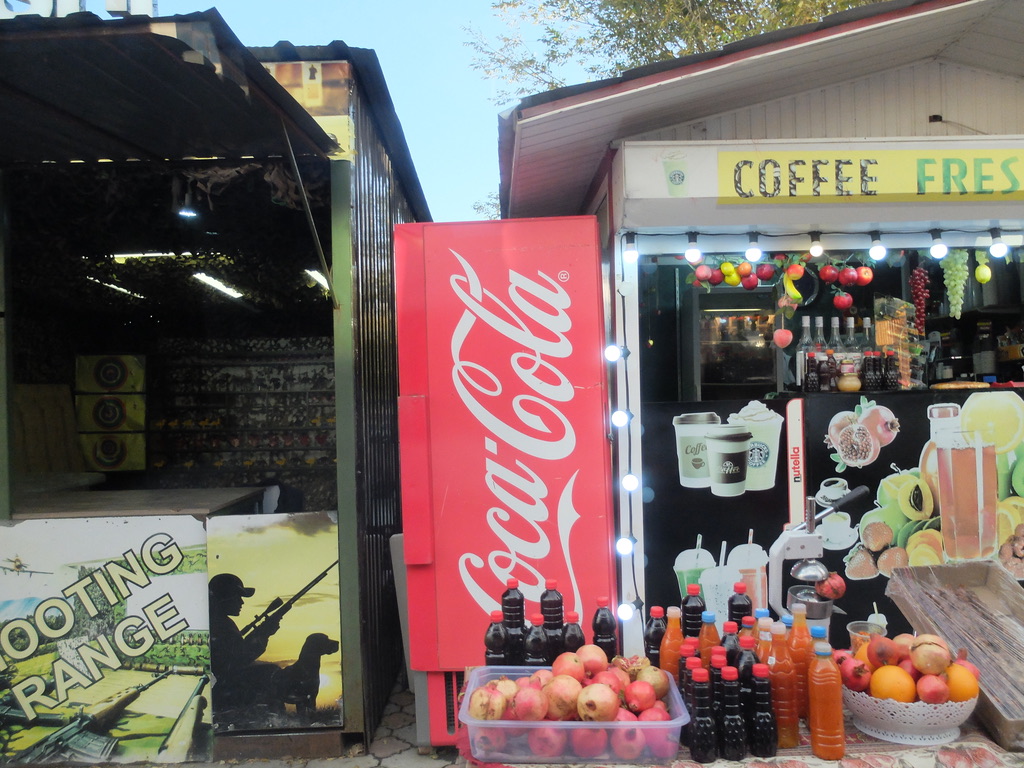
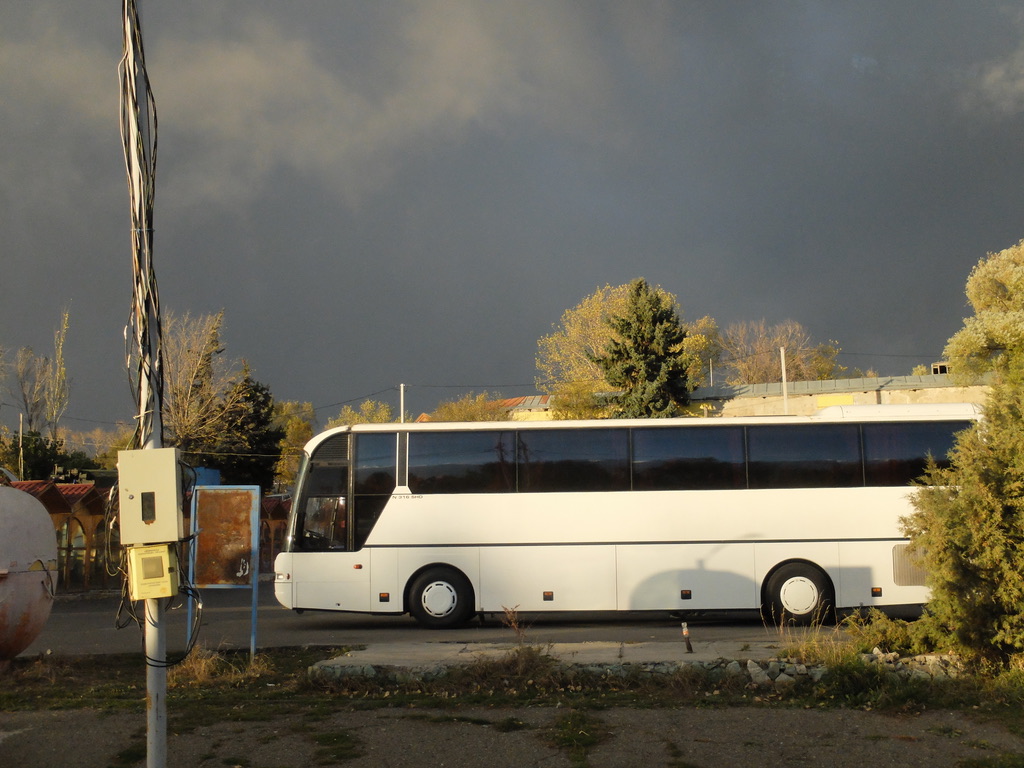


I got inside the vehicle, and before we slid the door close for the meantime, we were delightfully surprised as we saw the rain transform into flat, bigger, white specks — snow!!!
Our first snow of that new winter. Dad and our guest came back quite soaked and laughed at how it was snowing. We drove away from the town, and the weather changed from pouring to a clear one (“it’s like the American South!” we joked). The sun sank lower as we stared out the windows to see the fields passing by… I listened to “52:10” by Rich Mullins, a wide-open field kind of song, a reverent song.
“The Lord has bared His Holy arm
In the sight of all the nations
And all the ends of the earth shall see
The Lord’s salvation”
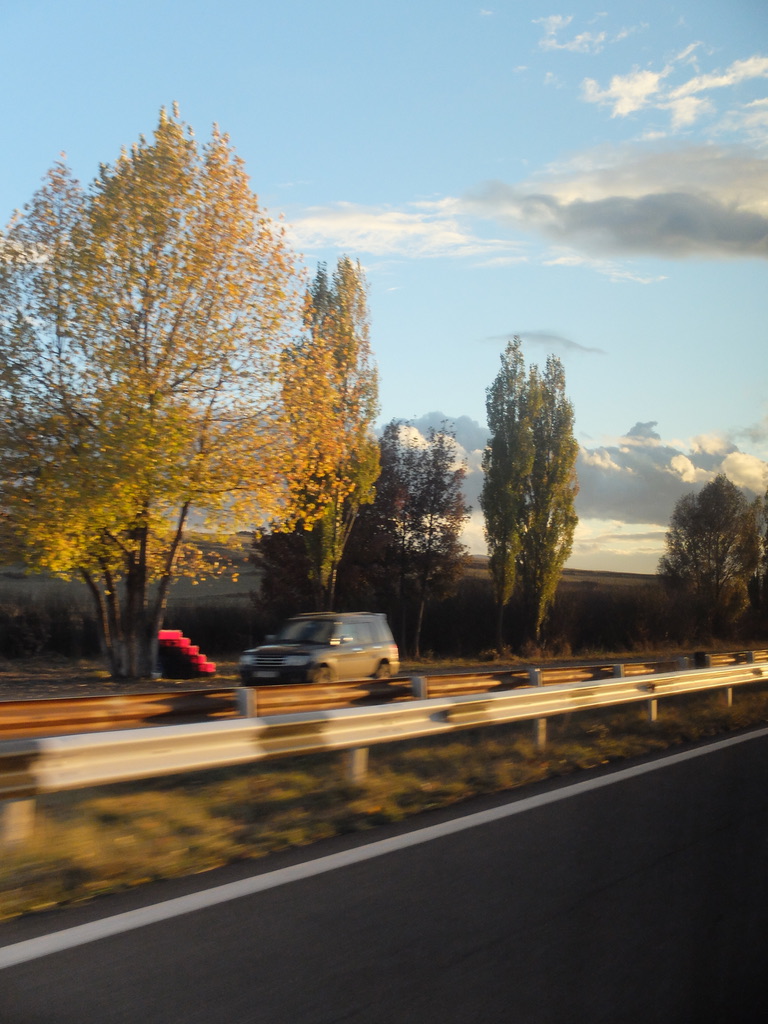
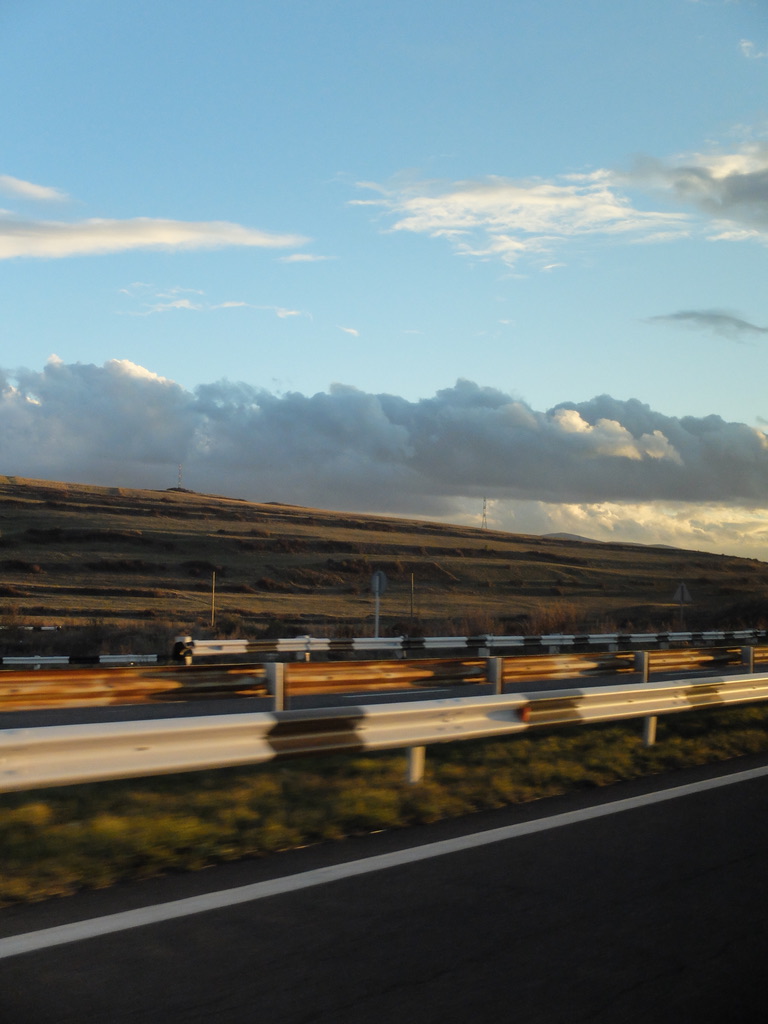
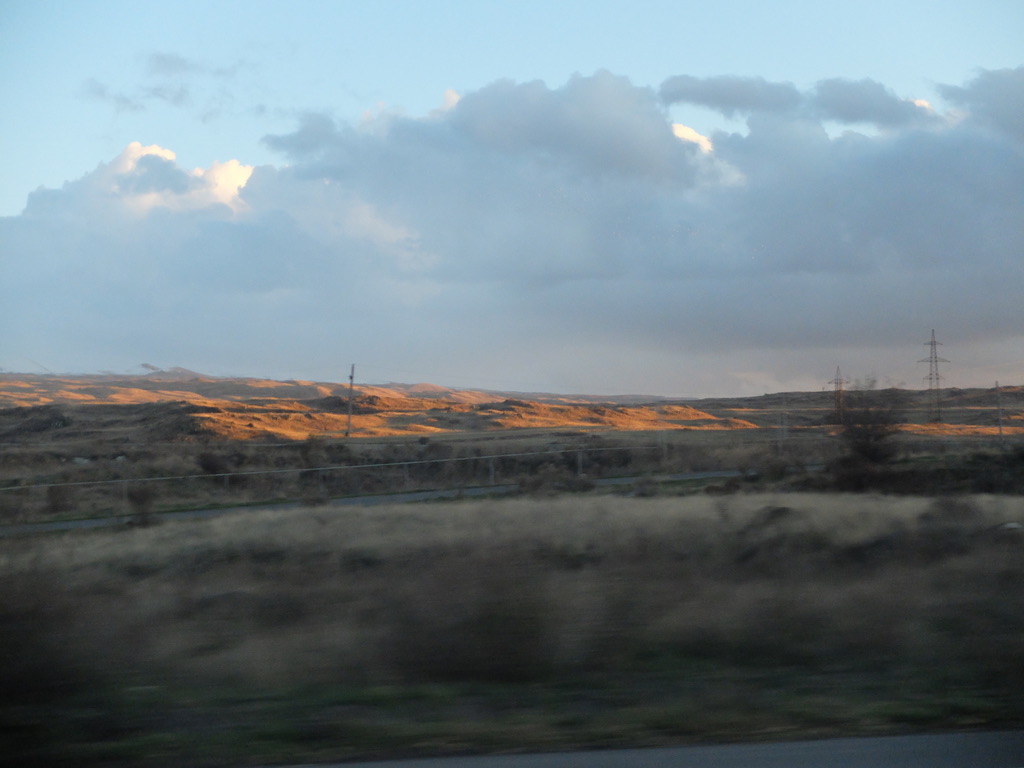
Looking back at this day in the dead of winter, I realise that God answered my prayer to give me a moment with His nature. The natural world in one sense of the word, and His personality, His character on the other. And I am grateful that those places hold so many memories for us - pockets of memories that I can access and savour and enjoy when I visit them again in different seasons and to look back fondly on them. I am glad I was able to disconnect from the dis-reality of social media and commune with God and my friends and family in these jewels of Armenia, too.
